Employee Recruitment, Selection, and Training at Nestle: Analysis
VerifiedAdded on 2021/02/20
|27
|4970
|74
Report
AI Summary
This report analyzes Nestle's employee recruitment, selection, and training strategies to meet international standards. It begins with an introduction outlining the research background, rationale, and aims. The report covers project management aspects, including scope, cost, time, communication, and risk management. The methodology section details the research type, approach, and philosophy, along with sampling techniques and data collection methods. Data analysis and interpretation are presented, focusing on the skills needed by Nestle employees, recruitment and selection methods, and training types. The findings reveal the importance of communication, cross-cultural management, and teamwork. The report also discusses the use of interviews and aptitude tests in recruitment. The report concludes with recommendations for improving recruitment, selection, and training processes within Nestle, along with a reflection on the learning experience.

MANAGING A
SUCCESSFUL BUSINESS
PROJECT
SUCCESSFUL BUSINESS
PROJECT
Paraphrase This Document
Need a fresh take? Get an instant paraphrase of this document with our AI Paraphraser
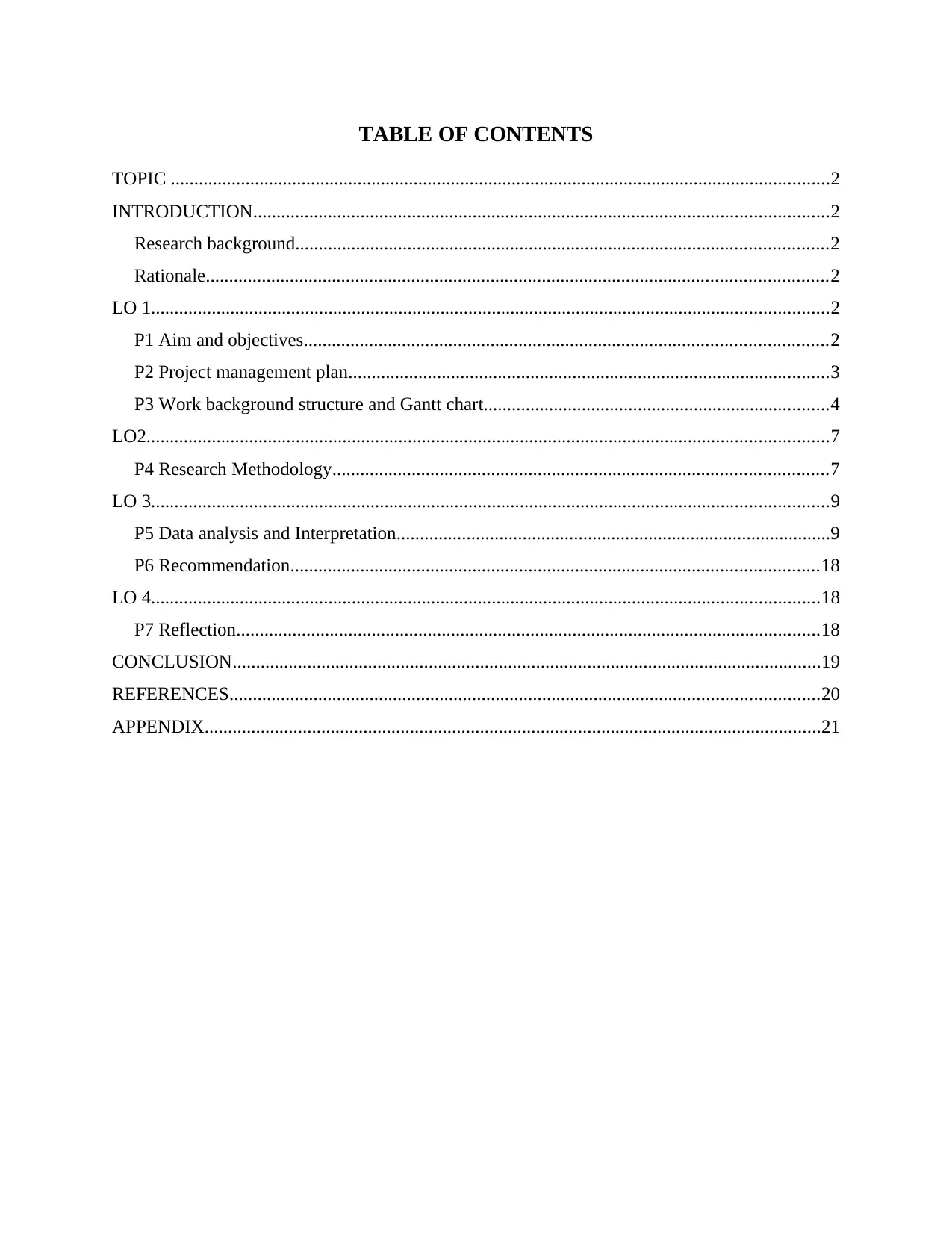
TABLE OF CONTENTS
TOPIC .............................................................................................................................................2
INTRODUCTION...........................................................................................................................2
Research background..................................................................................................................2
Rationale.....................................................................................................................................2
LO 1.................................................................................................................................................2
P1 Aim and objectives................................................................................................................2
P2 Project management plan.......................................................................................................3
P3 Work background structure and Gantt chart..........................................................................4
LO2..................................................................................................................................................7
P4 Research Methodology..........................................................................................................7
LO 3.................................................................................................................................................9
P5 Data analysis and Interpretation.............................................................................................9
P6 Recommendation.................................................................................................................18
LO 4...............................................................................................................................................18
P7 Reflection.............................................................................................................................18
CONCLUSION..............................................................................................................................19
REFERENCES..............................................................................................................................20
APPENDIX....................................................................................................................................21
TOPIC .............................................................................................................................................2
INTRODUCTION...........................................................................................................................2
Research background..................................................................................................................2
Rationale.....................................................................................................................................2
LO 1.................................................................................................................................................2
P1 Aim and objectives................................................................................................................2
P2 Project management plan.......................................................................................................3
P3 Work background structure and Gantt chart..........................................................................4
LO2..................................................................................................................................................7
P4 Research Methodology..........................................................................................................7
LO 3.................................................................................................................................................9
P5 Data analysis and Interpretation.............................................................................................9
P6 Recommendation.................................................................................................................18
LO 4...............................................................................................................................................18
P7 Reflection.............................................................................................................................18
CONCLUSION..............................................................................................................................19
REFERENCES..............................................................................................................................20
APPENDIX....................................................................................................................................21
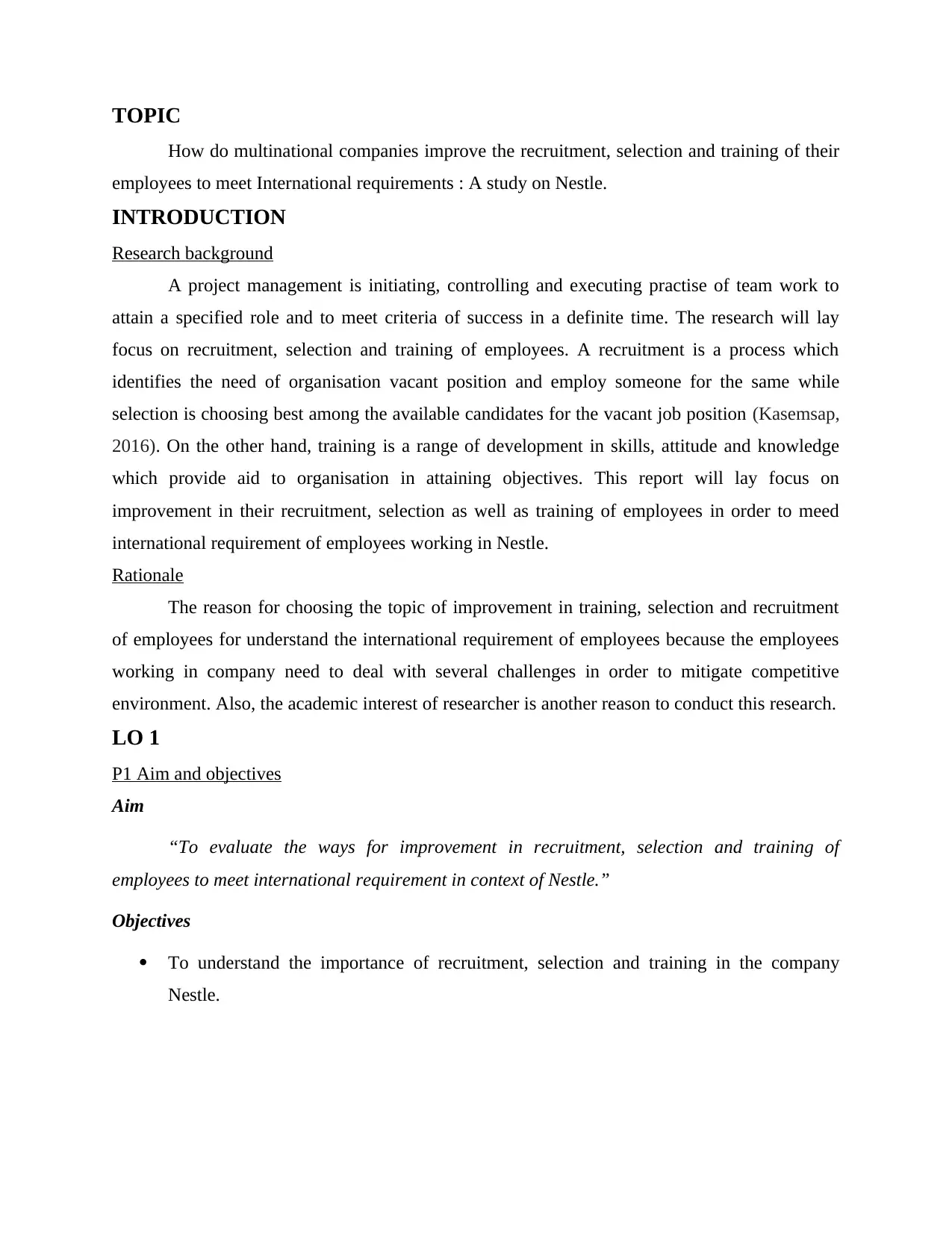
TOPIC
How do multinational companies improve the recruitment, selection and training of their
employees to meet International requirements : A study on Nestle.
INTRODUCTION
Research background
A project management is initiating, controlling and executing practise of team work to
attain a specified role and to meet criteria of success in a definite time. The research will lay
focus on recruitment, selection and training of employees. A recruitment is a process which
identifies the need of organisation vacant position and employ someone for the same while
selection is choosing best among the available candidates for the vacant job position (Kasemsap,
2016). On the other hand, training is a range of development in skills, attitude and knowledge
which provide aid to organisation in attaining objectives. This report will lay focus on
improvement in their recruitment, selection as well as training of employees in order to meed
international requirement of employees working in Nestle.
Rationale
The reason for choosing the topic of improvement in training, selection and recruitment
of employees for understand the international requirement of employees because the employees
working in company need to deal with several challenges in order to mitigate competitive
environment. Also, the academic interest of researcher is another reason to conduct this research.
LO 1
P1 Aim and objectives
Aim
“To evaluate the ways for improvement in recruitment, selection and training of
employees to meet international requirement in context of Nestle.”
Objectives
To understand the importance of recruitment, selection and training in the company
Nestle.
How do multinational companies improve the recruitment, selection and training of their
employees to meet International requirements : A study on Nestle.
INTRODUCTION
Research background
A project management is initiating, controlling and executing practise of team work to
attain a specified role and to meet criteria of success in a definite time. The research will lay
focus on recruitment, selection and training of employees. A recruitment is a process which
identifies the need of organisation vacant position and employ someone for the same while
selection is choosing best among the available candidates for the vacant job position (Kasemsap,
2016). On the other hand, training is a range of development in skills, attitude and knowledge
which provide aid to organisation in attaining objectives. This report will lay focus on
improvement in their recruitment, selection as well as training of employees in order to meed
international requirement of employees working in Nestle.
Rationale
The reason for choosing the topic of improvement in training, selection and recruitment
of employees for understand the international requirement of employees because the employees
working in company need to deal with several challenges in order to mitigate competitive
environment. Also, the academic interest of researcher is another reason to conduct this research.
LO 1
P1 Aim and objectives
Aim
“To evaluate the ways for improvement in recruitment, selection and training of
employees to meet international requirement in context of Nestle.”
Objectives
To understand the importance of recruitment, selection and training in the company
Nestle.
⊘ This is a preview!⊘
Do you want full access?
Subscribe today to unlock all pages.

Trusted by 1+ million students worldwide
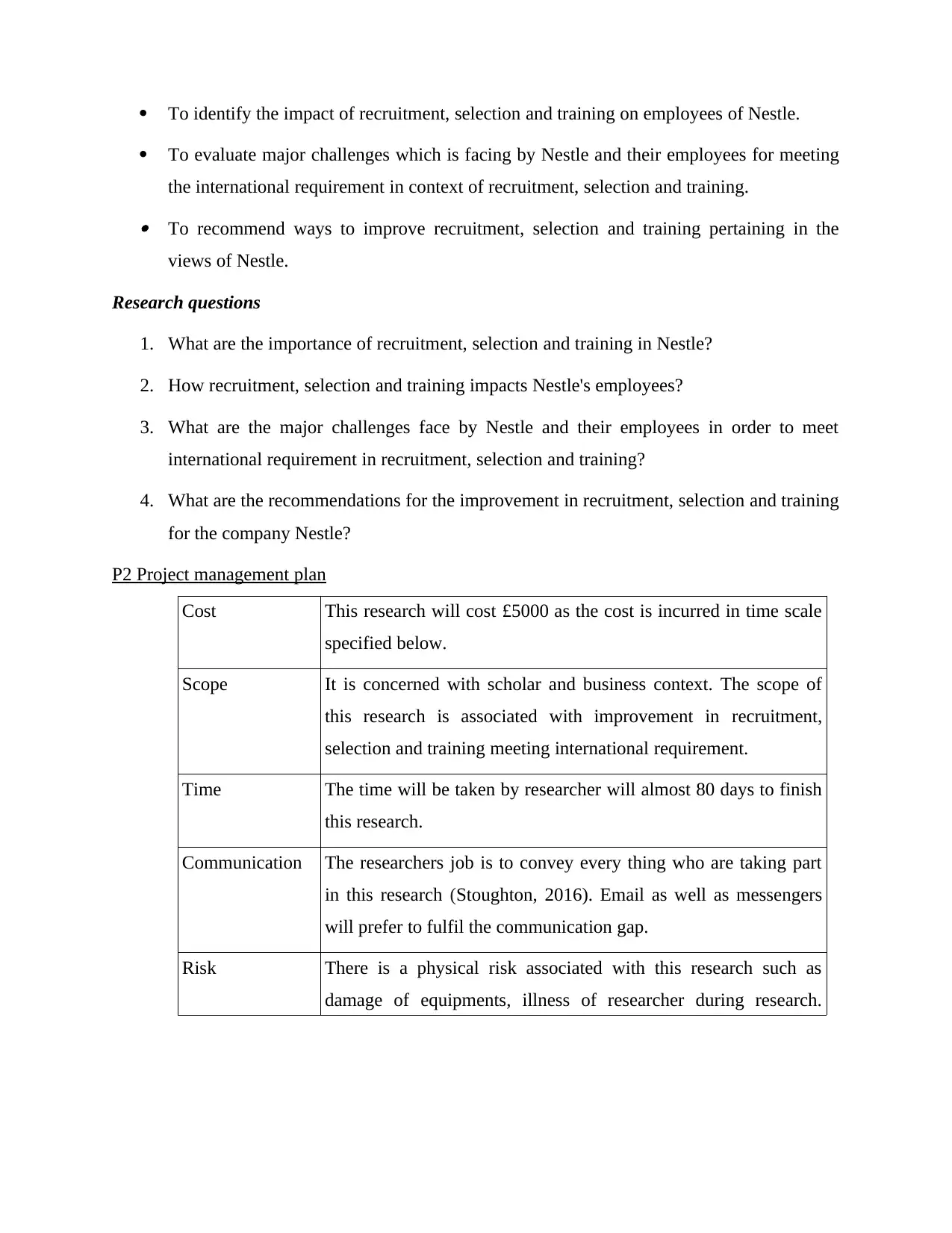
To identify the impact of recruitment, selection and training on employees of Nestle.
To evaluate major challenges which is facing by Nestle and their employees for meeting
the international requirement in context of recruitment, selection and training. To recommend ways to improve recruitment, selection and training pertaining in the
views of Nestle.
Research questions
1. What are the importance of recruitment, selection and training in Nestle?
2. How recruitment, selection and training impacts Nestle's employees?
3. What are the major challenges face by Nestle and their employees in order to meet
international requirement in recruitment, selection and training?
4. What are the recommendations for the improvement in recruitment, selection and training
for the company Nestle?
P2 Project management plan
Cost This research will cost £5000 as the cost is incurred in time scale
specified below.
Scope It is concerned with scholar and business context. The scope of
this research is associated with improvement in recruitment,
selection and training meeting international requirement.
Time The time will be taken by researcher will almost 80 days to finish
this research.
Communication The researchers job is to convey every thing who are taking part
in this research (Stoughton, 2016). Email as well as messengers
will prefer to fulfil the communication gap.
Risk There is a physical risk associated with this research such as
damage of equipments, illness of researcher during research.
To evaluate major challenges which is facing by Nestle and their employees for meeting
the international requirement in context of recruitment, selection and training. To recommend ways to improve recruitment, selection and training pertaining in the
views of Nestle.
Research questions
1. What are the importance of recruitment, selection and training in Nestle?
2. How recruitment, selection and training impacts Nestle's employees?
3. What are the major challenges face by Nestle and their employees in order to meet
international requirement in recruitment, selection and training?
4. What are the recommendations for the improvement in recruitment, selection and training
for the company Nestle?
P2 Project management plan
Cost This research will cost £5000 as the cost is incurred in time scale
specified below.
Scope It is concerned with scholar and business context. The scope of
this research is associated with improvement in recruitment,
selection and training meeting international requirement.
Time The time will be taken by researcher will almost 80 days to finish
this research.
Communication The researchers job is to convey every thing who are taking part
in this research (Stoughton, 2016). Email as well as messengers
will prefer to fulfil the communication gap.
Risk There is a physical risk associated with this research such as
damage of equipments, illness of researcher during research.
Paraphrase This Document
Need a fresh take? Get an instant paraphrase of this document with our AI Paraphraser
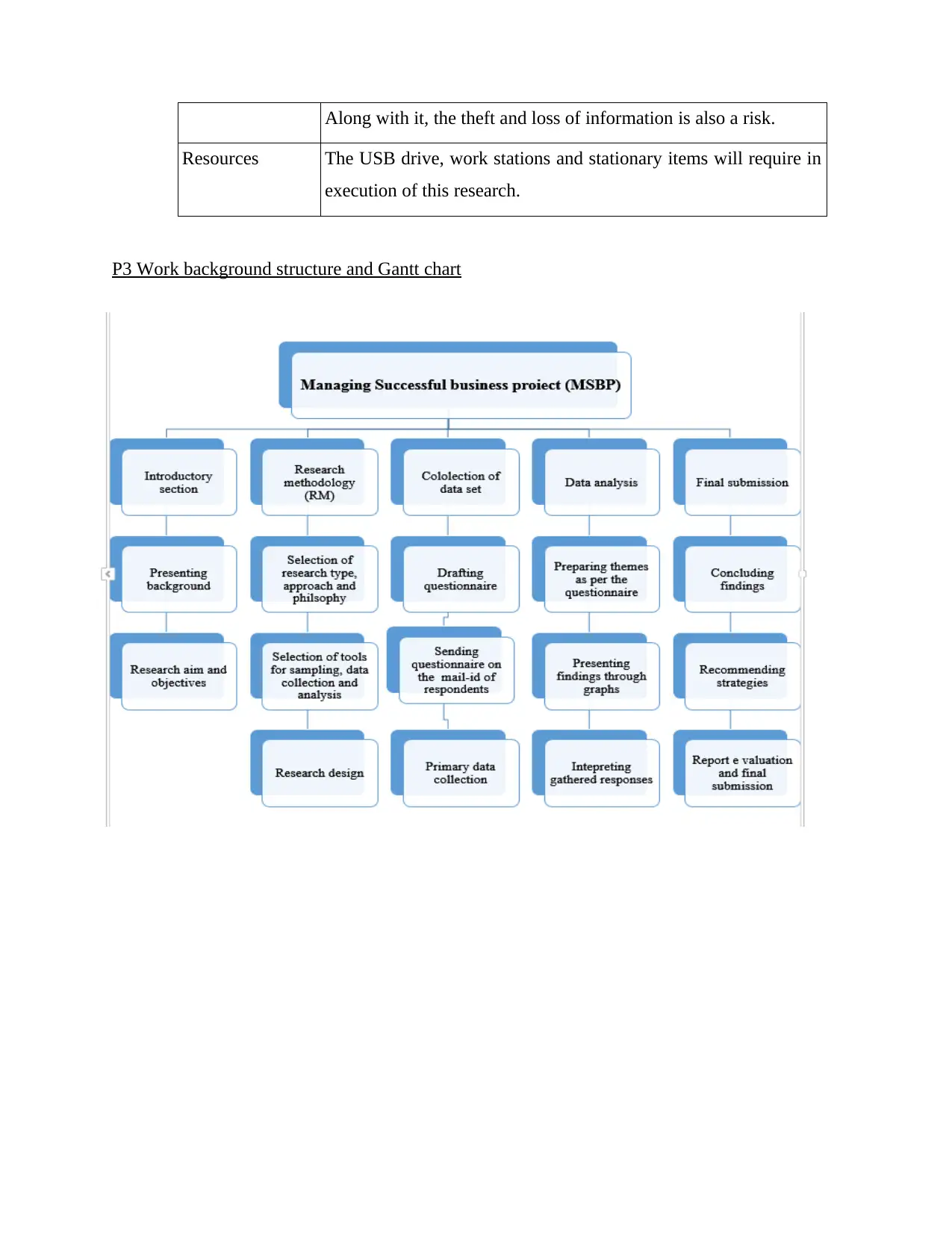
Along with it, the theft and loss of information is also a risk.
Resources The USB drive, work stations and stationary items will require in
execution of this research.
P3 Work background structure and Gantt chart
Resources The USB drive, work stations and stationary items will require in
execution of this research.
P3 Work background structure and Gantt chart
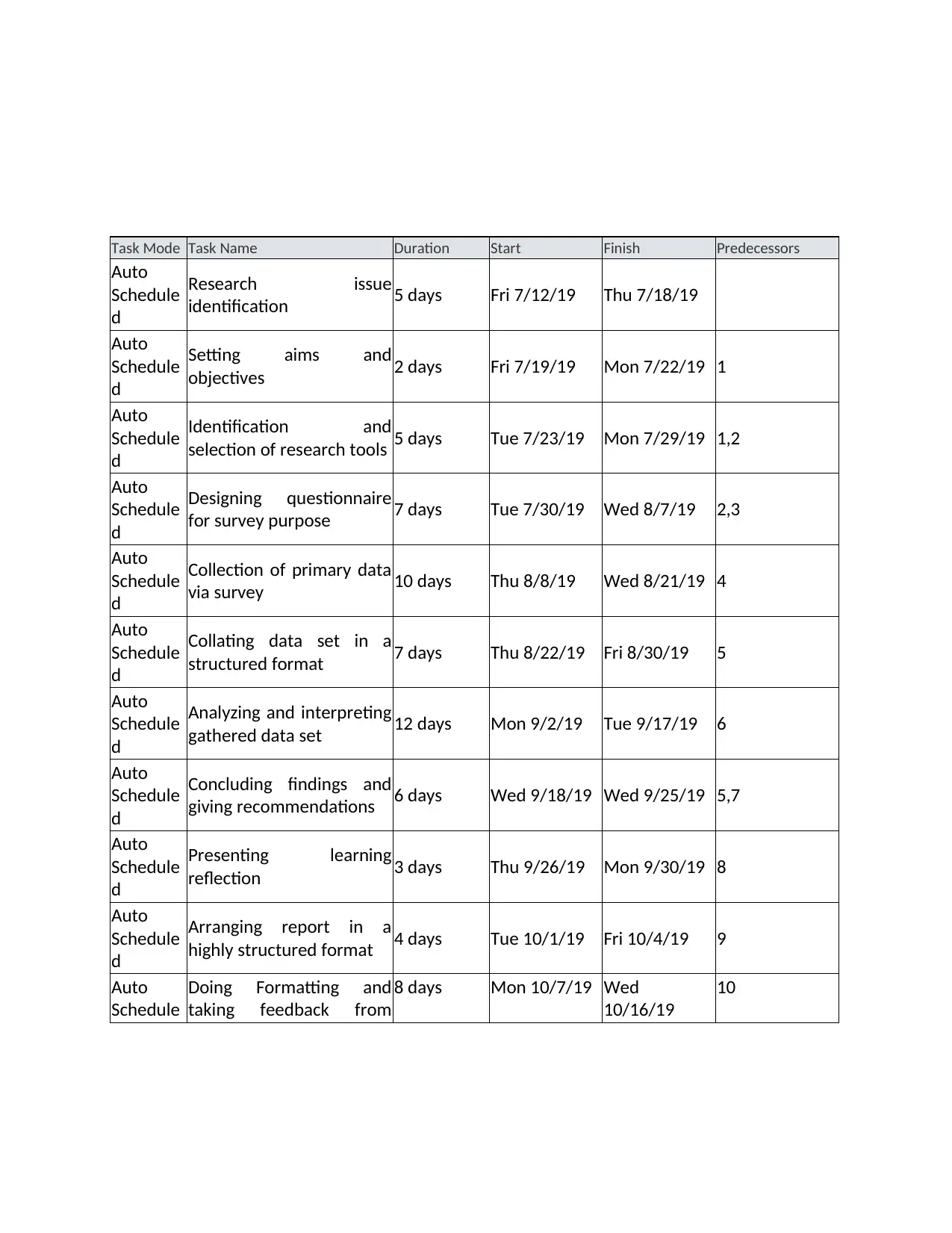
Task Mode Task Name Duration Start Finish Predecessors
Auto
Schedule
d
Research issue
identification 5 days Fri 7/12/19 Thu 7/18/19
Auto
Schedule
d
Setting aims and
objectives 2 days Fri 7/19/19 Mon 7/22/19 1
Auto
Schedule
d
Identification and
selection of research tools 5 days Tue 7/23/19 Mon 7/29/19 1,2
Auto
Schedule
d
Designing questionnaire
for survey purpose 7 days Tue 7/30/19 Wed 8/7/19 2,3
Auto
Schedule
d
Collection of primary data
via survey 10 days Thu 8/8/19 Wed 8/21/19 4
Auto
Schedule
d
Collating data set in a
structured format 7 days Thu 8/22/19 Fri 8/30/19 5
Auto
Schedule
d
Analyzing and interpreting
gathered data set 12 days Mon 9/2/19 Tue 9/17/19 6
Auto
Schedule
d
Concluding findings and
giving recommendations 6 days Wed 9/18/19 Wed 9/25/19 5,7
Auto
Schedule
d
Presenting learning
reflection 3 days Thu 9/26/19 Mon 9/30/19 8
Auto
Schedule
d
Arranging report in a
highly structured format 4 days Tue 10/1/19 Fri 10/4/19 9
Auto
Schedule
Doing Formatting and
taking feedback from
8 days Mon 10/7/19 Wed
10/16/19
10
Auto
Schedule
d
Research issue
identification 5 days Fri 7/12/19 Thu 7/18/19
Auto
Schedule
d
Setting aims and
objectives 2 days Fri 7/19/19 Mon 7/22/19 1
Auto
Schedule
d
Identification and
selection of research tools 5 days Tue 7/23/19 Mon 7/29/19 1,2
Auto
Schedule
d
Designing questionnaire
for survey purpose 7 days Tue 7/30/19 Wed 8/7/19 2,3
Auto
Schedule
d
Collection of primary data
via survey 10 days Thu 8/8/19 Wed 8/21/19 4
Auto
Schedule
d
Collating data set in a
structured format 7 days Thu 8/22/19 Fri 8/30/19 5
Auto
Schedule
d
Analyzing and interpreting
gathered data set 12 days Mon 9/2/19 Tue 9/17/19 6
Auto
Schedule
d
Concluding findings and
giving recommendations 6 days Wed 9/18/19 Wed 9/25/19 5,7
Auto
Schedule
d
Presenting learning
reflection 3 days Thu 9/26/19 Mon 9/30/19 8
Auto
Schedule
d
Arranging report in a
highly structured format 4 days Tue 10/1/19 Fri 10/4/19 9
Auto
Schedule
Doing Formatting and
taking feedback from
8 days Mon 10/7/19 Wed
10/16/19
10
⊘ This is a preview!⊘
Do you want full access?
Subscribe today to unlock all pages.

Trusted by 1+ million students worldwide
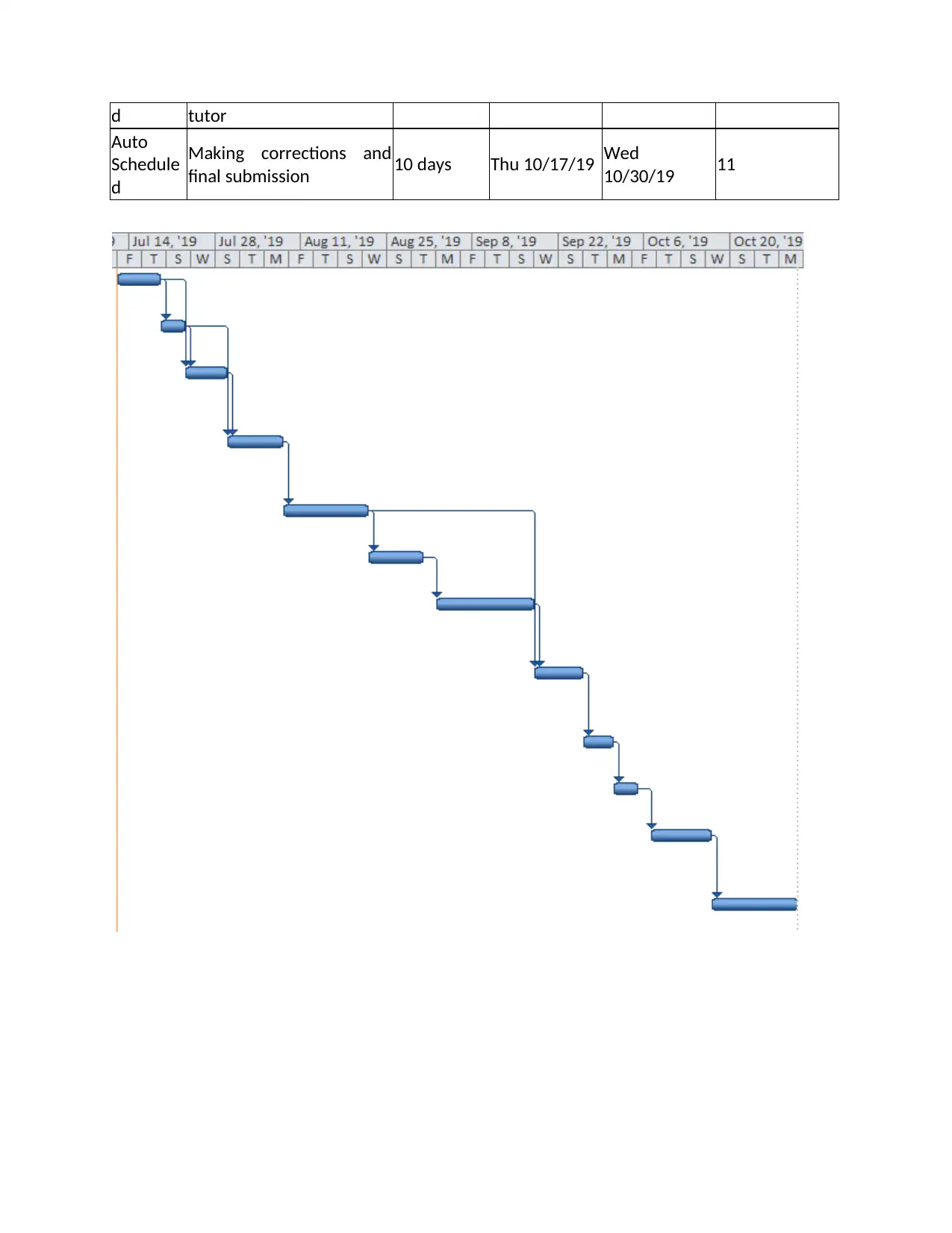
d tutor
Auto
Schedule
d
Making corrections and
final submission 10 days Thu 10/17/19 Wed
10/30/19 11
Auto
Schedule
d
Making corrections and
final submission 10 days Thu 10/17/19 Wed
10/30/19 11
Paraphrase This Document
Need a fresh take? Get an instant paraphrase of this document with our AI Paraphraser
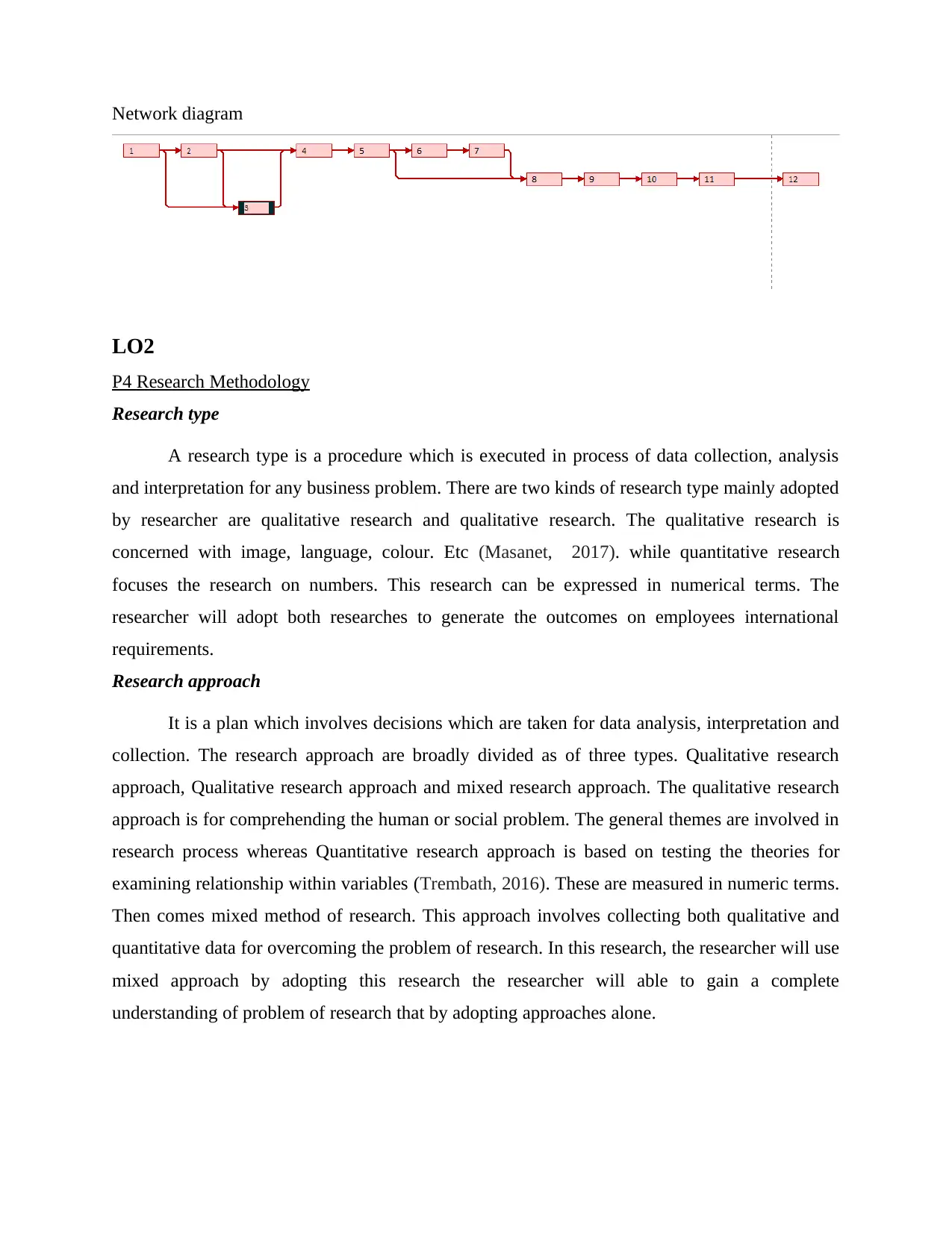
Network diagram
LO2
P4 Research Methodology
Research type
A research type is a procedure which is executed in process of data collection, analysis
and interpretation for any business problem. There are two kinds of research type mainly adopted
by researcher are qualitative research and qualitative research. The qualitative research is
concerned with image, language, colour. Etc (Masanet, 2017). while quantitative research
focuses the research on numbers. This research can be expressed in numerical terms. The
researcher will adopt both researches to generate the outcomes on employees international
requirements.
Research approach
It is a plan which involves decisions which are taken for data analysis, interpretation and
collection. The research approach are broadly divided as of three types. Qualitative research
approach, Qualitative research approach and mixed research approach. The qualitative research
approach is for comprehending the human or social problem. The general themes are involved in
research process whereas Quantitative research approach is based on testing the theories for
examining relationship within variables (Trembath, 2016). These are measured in numeric terms.
Then comes mixed method of research. This approach involves collecting both qualitative and
quantitative data for overcoming the problem of research. In this research, the researcher will use
mixed approach by adopting this research the researcher will able to gain a complete
understanding of problem of research that by adopting approaches alone.
LO2
P4 Research Methodology
Research type
A research type is a procedure which is executed in process of data collection, analysis
and interpretation for any business problem. There are two kinds of research type mainly adopted
by researcher are qualitative research and qualitative research. The qualitative research is
concerned with image, language, colour. Etc (Masanet, 2017). while quantitative research
focuses the research on numbers. This research can be expressed in numerical terms. The
researcher will adopt both researches to generate the outcomes on employees international
requirements.
Research approach
It is a plan which involves decisions which are taken for data analysis, interpretation and
collection. The research approach are broadly divided as of three types. Qualitative research
approach, Qualitative research approach and mixed research approach. The qualitative research
approach is for comprehending the human or social problem. The general themes are involved in
research process whereas Quantitative research approach is based on testing the theories for
examining relationship within variables (Trembath, 2016). These are measured in numeric terms.
Then comes mixed method of research. This approach involves collecting both qualitative and
quantitative data for overcoming the problem of research. In this research, the researcher will use
mixed approach by adopting this research the researcher will able to gain a complete
understanding of problem of research that by adopting approaches alone.
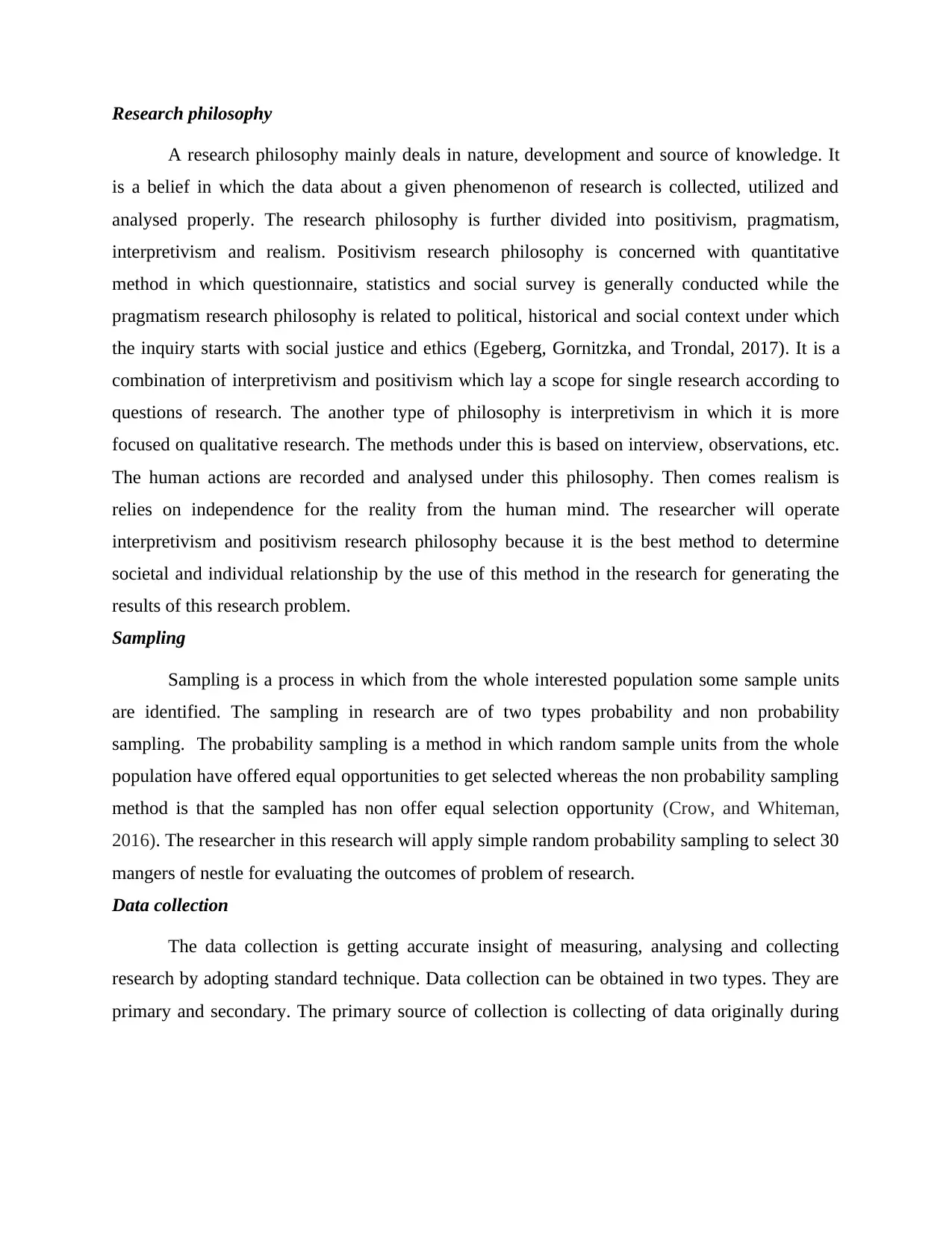
Research philosophy
A research philosophy mainly deals in nature, development and source of knowledge. It
is a belief in which the data about a given phenomenon of research is collected, utilized and
analysed properly. The research philosophy is further divided into positivism, pragmatism,
interpretivism and realism. Positivism research philosophy is concerned with quantitative
method in which questionnaire, statistics and social survey is generally conducted while the
pragmatism research philosophy is related to political, historical and social context under which
the inquiry starts with social justice and ethics (Egeberg, Gornitzka, and Trondal, 2017). It is a
combination of interpretivism and positivism which lay a scope for single research according to
questions of research. The another type of philosophy is interpretivism in which it is more
focused on qualitative research. The methods under this is based on interview, observations, etc.
The human actions are recorded and analysed under this philosophy. Then comes realism is
relies on independence for the reality from the human mind. The researcher will operate
interpretivism and positivism research philosophy because it is the best method to determine
societal and individual relationship by the use of this method in the research for generating the
results of this research problem.
Sampling
Sampling is a process in which from the whole interested population some sample units
are identified. The sampling in research are of two types probability and non probability
sampling. The probability sampling is a method in which random sample units from the whole
population have offered equal opportunities to get selected whereas the non probability sampling
method is that the sampled has non offer equal selection opportunity (Crow, and Whiteman,
2016). The researcher in this research will apply simple random probability sampling to select 30
mangers of nestle for evaluating the outcomes of problem of research.
Data collection
The data collection is getting accurate insight of measuring, analysing and collecting
research by adopting standard technique. Data collection can be obtained in two types. They are
primary and secondary. The primary source of collection is collecting of data originally during
A research philosophy mainly deals in nature, development and source of knowledge. It
is a belief in which the data about a given phenomenon of research is collected, utilized and
analysed properly. The research philosophy is further divided into positivism, pragmatism,
interpretivism and realism. Positivism research philosophy is concerned with quantitative
method in which questionnaire, statistics and social survey is generally conducted while the
pragmatism research philosophy is related to political, historical and social context under which
the inquiry starts with social justice and ethics (Egeberg, Gornitzka, and Trondal, 2017). It is a
combination of interpretivism and positivism which lay a scope for single research according to
questions of research. The another type of philosophy is interpretivism in which it is more
focused on qualitative research. The methods under this is based on interview, observations, etc.
The human actions are recorded and analysed under this philosophy. Then comes realism is
relies on independence for the reality from the human mind. The researcher will operate
interpretivism and positivism research philosophy because it is the best method to determine
societal and individual relationship by the use of this method in the research for generating the
results of this research problem.
Sampling
Sampling is a process in which from the whole interested population some sample units
are identified. The sampling in research are of two types probability and non probability
sampling. The probability sampling is a method in which random sample units from the whole
population have offered equal opportunities to get selected whereas the non probability sampling
method is that the sampled has non offer equal selection opportunity (Crow, and Whiteman,
2016). The researcher in this research will apply simple random probability sampling to select 30
mangers of nestle for evaluating the outcomes of problem of research.
Data collection
The data collection is getting accurate insight of measuring, analysing and collecting
research by adopting standard technique. Data collection can be obtained in two types. They are
primary and secondary. The primary source of collection is collecting of data originally during
⊘ This is a preview!⊘
Do you want full access?
Subscribe today to unlock all pages.

Trusted by 1+ million students worldwide
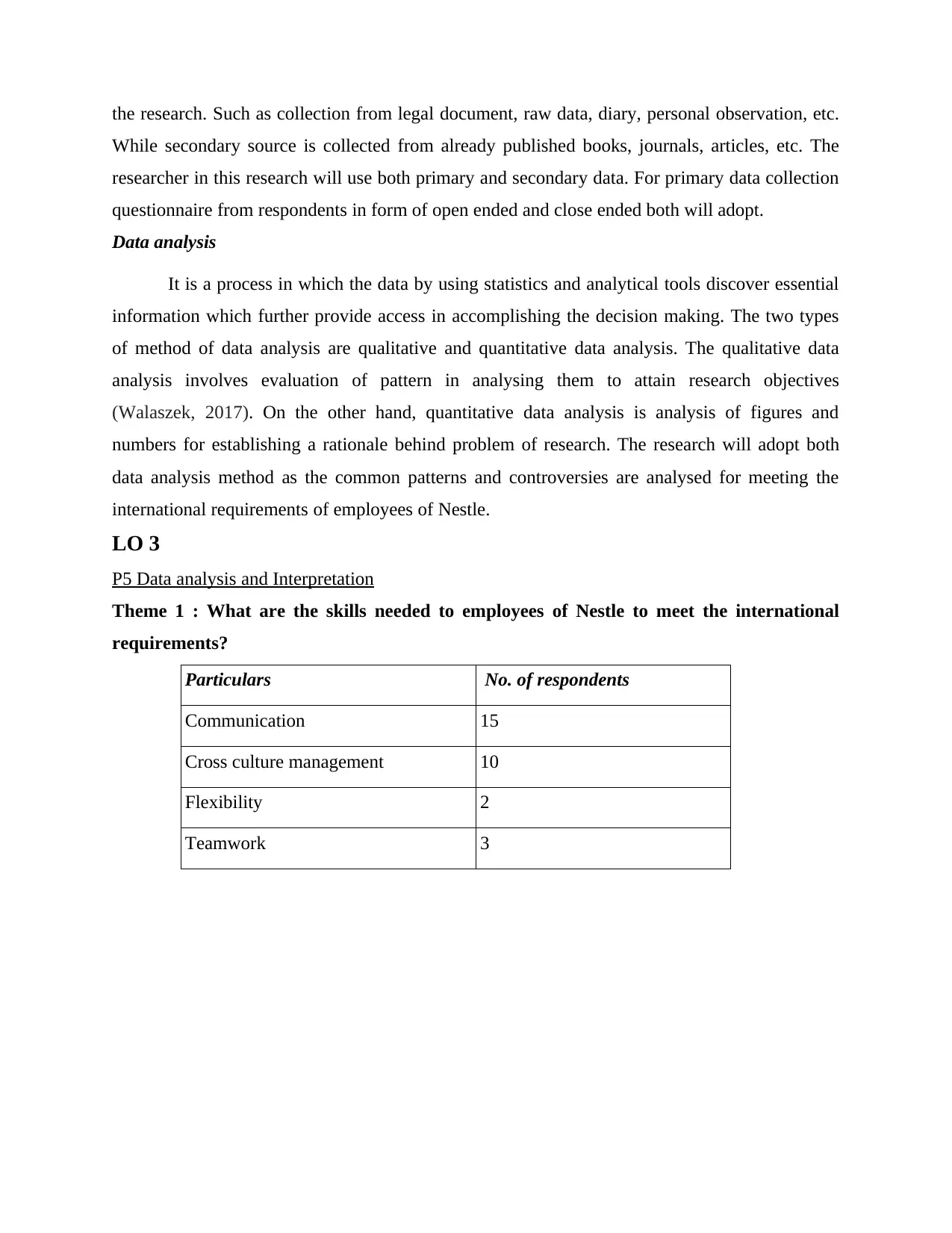
the research. Such as collection from legal document, raw data, diary, personal observation, etc.
While secondary source is collected from already published books, journals, articles, etc. The
researcher in this research will use both primary and secondary data. For primary data collection
questionnaire from respondents in form of open ended and close ended both will adopt.
Data analysis
It is a process in which the data by using statistics and analytical tools discover essential
information which further provide access in accomplishing the decision making. The two types
of method of data analysis are qualitative and quantitative data analysis. The qualitative data
analysis involves evaluation of pattern in analysing them to attain research objectives
(Walaszek, 2017). On the other hand, quantitative data analysis is analysis of figures and
numbers for establishing a rationale behind problem of research. The research will adopt both
data analysis method as the common patterns and controversies are analysed for meeting the
international requirements of employees of Nestle.
LO 3
P5 Data analysis and Interpretation
Theme 1 : What are the skills needed to employees of Nestle to meet the international
requirements?
Particulars No. of respondents
Communication 15
Cross culture management 10
Flexibility 2
Teamwork 3
While secondary source is collected from already published books, journals, articles, etc. The
researcher in this research will use both primary and secondary data. For primary data collection
questionnaire from respondents in form of open ended and close ended both will adopt.
Data analysis
It is a process in which the data by using statistics and analytical tools discover essential
information which further provide access in accomplishing the decision making. The two types
of method of data analysis are qualitative and quantitative data analysis. The qualitative data
analysis involves evaluation of pattern in analysing them to attain research objectives
(Walaszek, 2017). On the other hand, quantitative data analysis is analysis of figures and
numbers for establishing a rationale behind problem of research. The research will adopt both
data analysis method as the common patterns and controversies are analysed for meeting the
international requirements of employees of Nestle.
LO 3
P5 Data analysis and Interpretation
Theme 1 : What are the skills needed to employees of Nestle to meet the international
requirements?
Particulars No. of respondents
Communication 15
Cross culture management 10
Flexibility 2
Teamwork 3
Paraphrase This Document
Need a fresh take? Get an instant paraphrase of this document with our AI Paraphraser
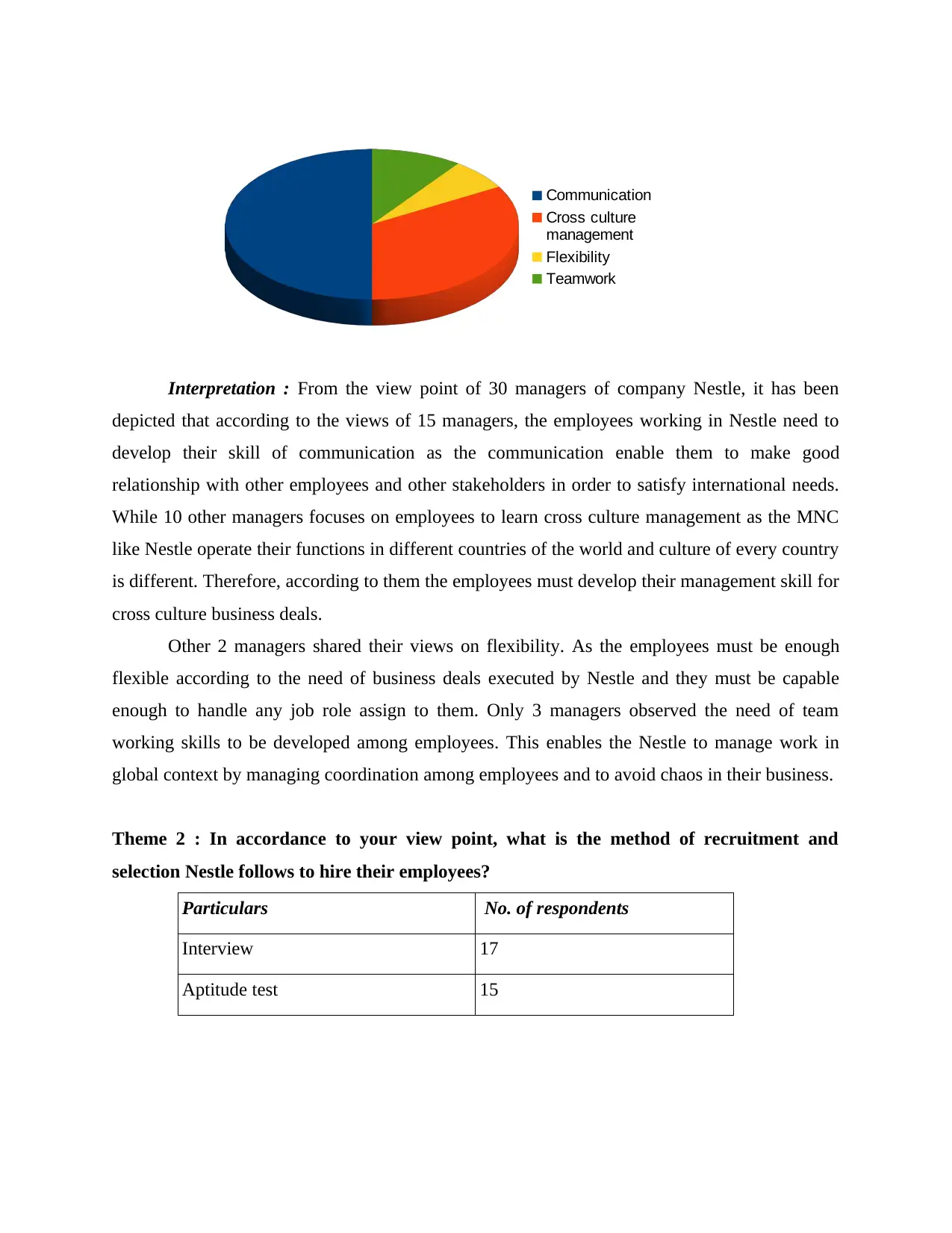
Interpretation : From the view point of 30 managers of company Nestle, it has been
depicted that according to the views of 15 managers, the employees working in Nestle need to
develop their skill of communication as the communication enable them to make good
relationship with other employees and other stakeholders in order to satisfy international needs.
While 10 other managers focuses on employees to learn cross culture management as the MNC
like Nestle operate their functions in different countries of the world and culture of every country
is different. Therefore, according to them the employees must develop their management skill for
cross culture business deals.
Other 2 managers shared their views on flexibility. As the employees must be enough
flexible according to the need of business deals executed by Nestle and they must be capable
enough to handle any job role assign to them. Only 3 managers observed the need of team
working skills to be developed among employees. This enables the Nestle to manage work in
global context by managing coordination among employees and to avoid chaos in their business.
Theme 2 : In accordance to your view point, what is the method of recruitment and
selection Nestle follows to hire their employees?
Particulars No. of respondents
Interview 17
Aptitude test 15
Communication
Cross culture
management
Flexibility
Teamwork
depicted that according to the views of 15 managers, the employees working in Nestle need to
develop their skill of communication as the communication enable them to make good
relationship with other employees and other stakeholders in order to satisfy international needs.
While 10 other managers focuses on employees to learn cross culture management as the MNC
like Nestle operate their functions in different countries of the world and culture of every country
is different. Therefore, according to them the employees must develop their management skill for
cross culture business deals.
Other 2 managers shared their views on flexibility. As the employees must be enough
flexible according to the need of business deals executed by Nestle and they must be capable
enough to handle any job role assign to them. Only 3 managers observed the need of team
working skills to be developed among employees. This enables the Nestle to manage work in
global context by managing coordination among employees and to avoid chaos in their business.
Theme 2 : In accordance to your view point, what is the method of recruitment and
selection Nestle follows to hire their employees?
Particulars No. of respondents
Interview 17
Aptitude test 15
Communication
Cross culture
management
Flexibility
Teamwork
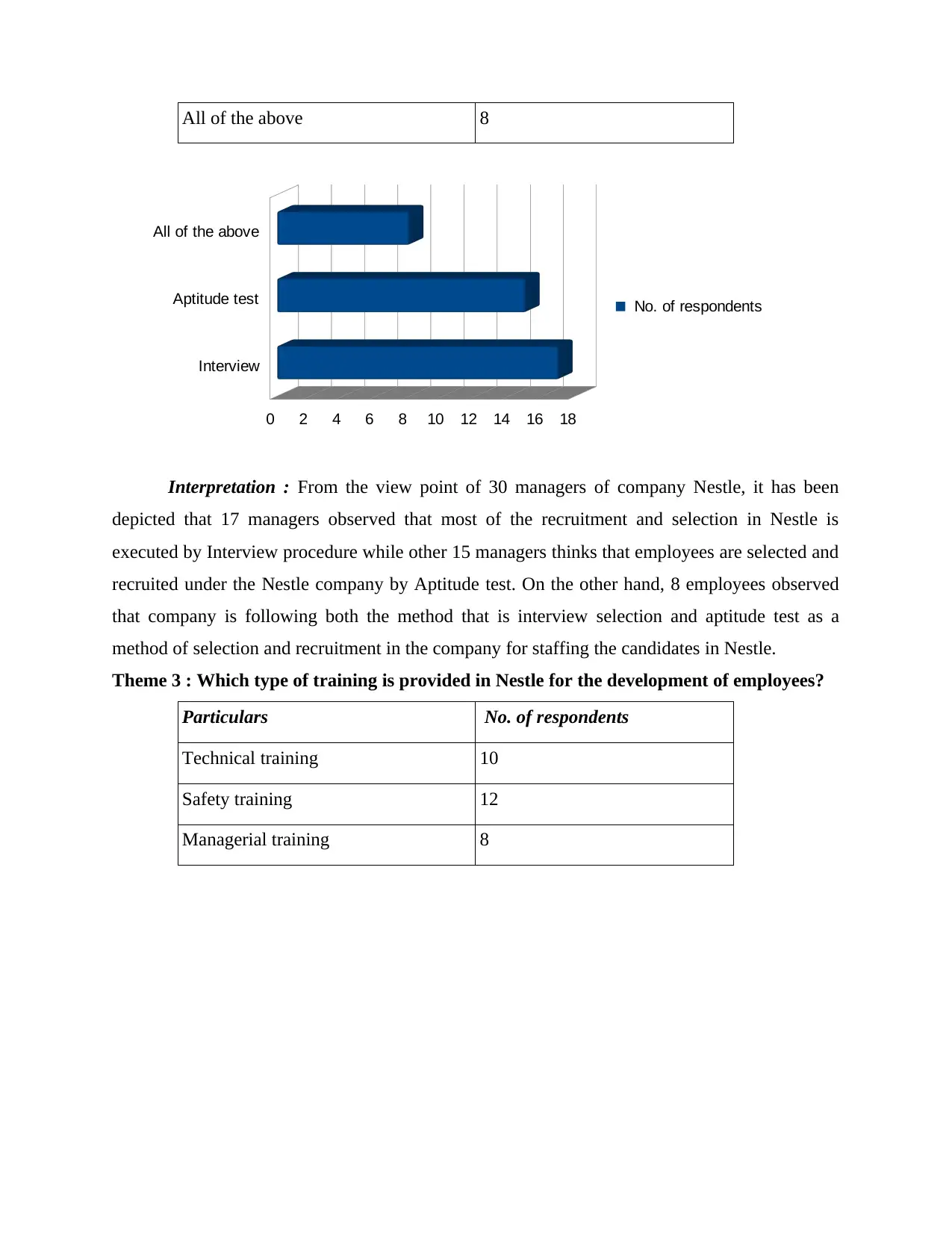
All of the above 8
Interpretation : From the view point of 30 managers of company Nestle, it has been
depicted that 17 managers observed that most of the recruitment and selection in Nestle is
executed by Interview procedure while other 15 managers thinks that employees are selected and
recruited under the Nestle company by Aptitude test. On the other hand, 8 employees observed
that company is following both the method that is interview selection and aptitude test as a
method of selection and recruitment in the company for staffing the candidates in Nestle.
Theme 3 : Which type of training is provided in Nestle for the development of employees?
Particulars No. of respondents
Technical training 10
Safety training 12
Managerial training 8
Interview
Aptitude test
All of the above
0 2 4 6 8 10 12 14 16 18
No. of respondents
Interpretation : From the view point of 30 managers of company Nestle, it has been
depicted that 17 managers observed that most of the recruitment and selection in Nestle is
executed by Interview procedure while other 15 managers thinks that employees are selected and
recruited under the Nestle company by Aptitude test. On the other hand, 8 employees observed
that company is following both the method that is interview selection and aptitude test as a
method of selection and recruitment in the company for staffing the candidates in Nestle.
Theme 3 : Which type of training is provided in Nestle for the development of employees?
Particulars No. of respondents
Technical training 10
Safety training 12
Managerial training 8
Interview
Aptitude test
All of the above
0 2 4 6 8 10 12 14 16 18
No. of respondents
⊘ This is a preview!⊘
Do you want full access?
Subscribe today to unlock all pages.

Trusted by 1+ million students worldwide
1 out of 27
Related Documents
Your All-in-One AI-Powered Toolkit for Academic Success.
+13062052269
info@desklib.com
Available 24*7 on WhatsApp / Email
![[object Object]](/_next/static/media/star-bottom.7253800d.svg)
Unlock your academic potential
Copyright © 2020–2025 A2Z Services. All Rights Reserved. Developed and managed by ZUCOL.





